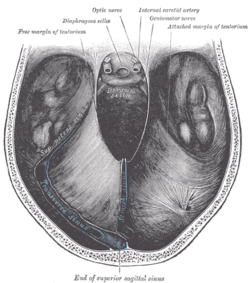Tentorium Cerebelli
From Wikipedia, the free encyclopedia
| Brain: Tentorium cerebelli | ||
|---|---|---|
 | ||
 | ||
| Tentorium cerebelli seen from above. | ||
| subject #193 874 | ||
| Meninges | ||
| ancil-261 | ||
The tentorium cerebelli or cerebellar tentorium (Latin: "tent of the cerebellum") is an extension of the dura mater that separates the cerebellum from the inferior portion of the occipital lobes.
Anatomy
The tentorium cerebelli is an arched lamina, elevated in the middle, and inclining downward toward the circumference.
It covers the superior surface of the cerebellum, and supports the occipital lobes of the brain.
Its anterior border is free and concave, and bounds a large oval opening, the incisura tentorii, for the transmission of the cerebral peduncles.
It is attached, behind, by its convex border, to the transverse ridges upon the inner surface of the occipital bone, and there encloses the transverse sinuses; in front, to the superior angle of the petrous part of the temporal bone on either side, enclosing the superior petrosal sinuses.
At the apex of the petrous part of the temporal bone the free and attached borders meet, and, crossing one another, are continued forward to be fixed to the anterior and posterior clinoid processes respectively.
To the middle line of its upper surface the posterior border of the falx cerebri is attached, the straight sinus being placed at their line of junction.
Clinical significance
Clinically, the tentorium is important because brain tumors are often characterized as supratentorial (above the tentorium) and infratentorial (below the tentorium). The location of the tumor can help in determining the type of tumor, as different tumors occur with different frequencies at each location. Additionally, most childhood tumors are infratentorial, while most adult tumors are supratentorial. The location of the tumor may have prognostic significance as well.
Since the tentorium is a hard structure, if there is a volume expansion in the parenchyme above the tentorium, the brain can get pushed down partly through the tentorium. This is called herniation and will often give mydriasis on the affected side, due to pressure on cranial nerve III (N. Oculomotorius). Tentorial herniation is a serious symptom, especially since the brainstem is likely to be compressed as well if the intracranial pressure rises further.

0 comments:
Post a Comment